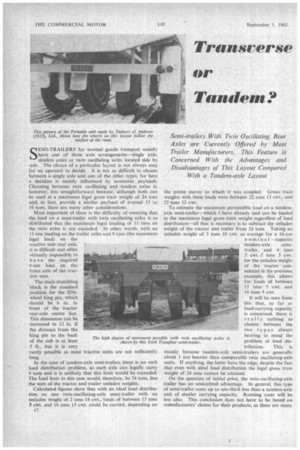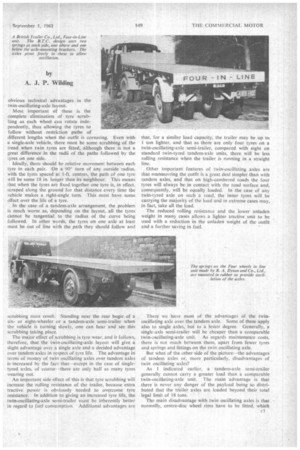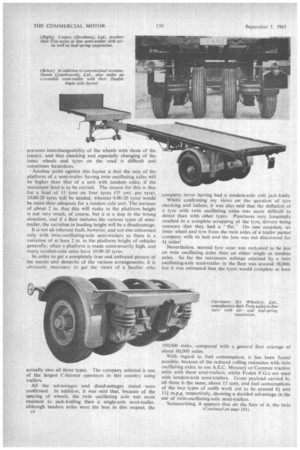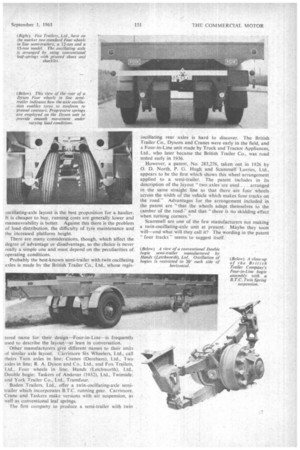Transuerse or Tandem?
Page 54

Page 55

Page 56

Page 59

If you've noticed an error in this article please click here to report it so we can fix it.
Semi-trailers With Twin Oscillating Rear .Axles are Currently Offered by Most Trailer Manufacturers. This Feature is Concerned With the Advantages and Disadvantages of This Layout Compared
With a Tandem-axle Layout by A. J. P. Wilding
EMI-TRAILERS for normal goods transport usually Cl have one of three axle arrangements—single axle, tandem axles or twin oscillating axles located side by side. The choice of a particular layout is not always easy for an operator to decide. It is not so difficult to choose between a single axle and one of the other types, for here a decision is mainly influenced by economic payloads. Choosing between twin oscillating and tandem axles is, however, less straightforward because. although both can be used at a maximum legal gross train weight of 24 tons and, in fact, provide a siinilar payload of around 15 or 16 tons, there are many other considerations.
Most important of these is the difficulty of ensuring that the load on a semi-trailer with twin oscillating axles is so distributed that the maximum legal loading of 11 tons on the twin axles is not exceeded. In other words, with an 11-ton loading on the trailer axles and 9 tons (the maximum legal load) on the tractive unit rear axle, it is difficult and often virtually impossible to have the required 4-ton load on the front axle of the tractive unit.
The main stumbling block is the standard position for the fifthwheel king pin, which should be 6 in. in front of the tractor rear-axle centre line. This dimension can be increased to 12 in. if the distance from the king pin to the back of the cab is at least 5 ft., but it is very rarely possible as most tractive units are not sufficiently long.
In the case of tandem-axle semi-trailers there is no such load distribution problem, as each axle can legally carry 9 tons and it is unlikely that this limit would be exceeded. The load limit in this case would, therefore, be 24 tons, less the sum of the tractor and trailer unladen weights.
Calculated figures show that with an ideal load distribution on one twin-oscillating-axle semi-trailer with an unladen weight of 2 tons 14 cwt., loath of between 15 tons 3 cwt. and 16 tons 15 cwt, could be carried, depending on The high degree of movement pass shown by this York 7' the prime mover to which it was coupled. Gross train weights with these loads were between 22 tons 13 cwt., and 23 tons 12 cwt.
To estimate the maximum permissible load on a tandemaxle semi-trailer—which I have already said can be loaded to the maximum legal gross train weight regardless of load distribution—all that is necessary is to subtract the unladen weight of the tractor and trailer from 24 tons. Taking an unladen weight of 3 tons 10 cwt. as average for a 16-ton nominal capacity
tandem-axle semitrailer, and 4 tons 5 ewt.-5 tons 5 cwt, for the unladen weight of the tractor considered in the previous example, this allows for loads of between
15 tons 5 cwt. and 16 tons 5 cwt.
It will be seen from this that, so far as load-carrying capacity is concerned, there is really nothing to choose between the two types always bearing in mind the problem of load distribution. This is mainly because tandem-axle semi-trailers are generally about 1 ton heavier than comparable twin oscillating-axle units. If anything. the latter have the edge, despite the fact that even with ideal load distribution the legal gross train weight of 24 tons cannot be attained.
On the question of initial price, the twin-oscillating-axle trailer has an undoubted advantage. In general, this type of semi-trailer costs up to one-third less than a tandem-axle unit of similar carrying capacity. Running costs will be less also. This conclusion does not have to be based on manufacturers' claims for their products, as there are many ibk with nein oscillating axles is ransfour semi-traller. obvious technical advantages in the twin-oscillating-axle layout.
Most important of these is the complete elimination of tyre scrubbing as each wheel can rotate independently, thus allowing the tyres to follow without restriction paths of different lengths when the outfit is cornering. Even with a single-axle vehicle, there must be some scrubbing of the tread when twin tyres are fitted, although there is not a great difference in the radii of the paths followed by the tyres on one side.
Ideally, there should be relative movement between each tyre in each pair. On a 900 turn of any outside radius, with the tyres spaced at I-ft. centres, the path of one tyre will be some 18 in. longer than its neighbour. This means that when the tyres are fixed together one tyre is, in effect. scraped along the ground for that distance every time the vehicle makes a right-angle turn. This must have some effect over the life of a tyre.
In the case of a tandem-axle arrangement, the problem is much worse as, depending on the layout, all the tyres cannot be tangential to the radius of the curve being followed. In other words, the tyres on one axle at least must be out of line with the path they should follow and scrubbing must result. Standing near the rear bogie of a sixor eight-wheeler or a tandem-axle semi-trailer when the vehicle is turning slowly, one can hear and see this scrubbing taking place.
The major effect of scrubbing is tyre wear, and it follows, therefore, that the twin-oscillating-axle layout will give a slight advantage over a single axle and a decided advantage over tandem axles in respect of tyre life. The advantage in terms of money of twin oscillating axles over tandem axles is increased by the fact that—except in the case of singletyred axles, of course-there are only half as many tyres wearing out.
An important side effect of this is that tyre scrubbing will increase the rolling resistance of the trailer, because extra tractive power is obviously needed to overcome tyre resistance. In addition to giving an increased tyre life, the twin-oscillating-axle semi-trailer must be inherently better in regard to fuel consumption. Additional advantages are that, for a similar load capacity. the trailer may be up to 1 ton lighter, and that as there are only four tyres on a twin-oscillating-axle semi-trailer, compared with eight on standard twin-tyred tandem-axle units, there will be less rolling resistance when the trailer is running in a straight line.
Other important features of twin-oscillating axles arc that manceuvring the outfit is a great deal simpler than with tandem axles, and that on high-cambered roads the four tyres will always be in contact with the road surface and, consequently, will be equally loaded. In the case of any twin-tyred axle on such a road, the inner tyres will be carrying the majority of the load and in extreme cases may, in fact, take all the load.
The reduced rolling resistance and the lower unladen weight in many cases allows a lighter tractive unit to be used with a reduction in the unladen weight of the outfit and a further saving in fuel.
There we have most of the advantages of the twinoscillating axle over the tandem axle. Some of these apply also to single axles, but to a lesser degree. Generally, a single-axle semi-trailer will be cheaper than a comparable twin-oscillating-axle unit. As regards maintenance costs, there is not much between them, apart from fewer tyres and springs and fittings on the twin oscillating axle.
But what of the other side of the picture—the advantages of tandem axles or, more particularly, disadvantages of twin oscillating axles?
As I indicated earlier, a tandem-axle semi-trailer generally cannot carry a greater load than a comparable twin-oscillating-axle unit. The main advantage is that there is never any danger of the payload being so distributed that the tiailer axles are loaded beyond their total legal limit of 18 tons.
The main disadvantage with twin oscillating axles is that normally, centre-disc wheel rims have to be fitted, which r3 prevents interchangeability of the wheels with those of the tractor, and that checking and especially changing of the inner wheels and tyres on the road is difficult and sometimes hazardous.
Another point against this layout is that the rear of the platform of a semi-trailer having twin oscillating axles will be higher than that of a unit with tandem aides, if the maximum load is to be carried. The reason for this is that for a load of 11 tons on four tyres (55 cwt. per tyre). 10.00-20 tyres will be needed, whereas 9.00-20 tyres would be more than adequate for a tandem axle unit. The increase of about 2 in. that this will make in the platform height is not very much, of course, but it is a step in the wrong direction, and if a fleet includes the various types of semitrailer, the variation in loading height will be a disadvantage.
It is not an inherent fault, however, and not one concerned only with twin-oscillating-axle semi-trailers as there is a variation of at least 2 in. in the platform height of vehicles generally; often a platform is made unnecessarily high, and many tandem-axle unit S have 10.00-20 tyres.
In order to get a completely true and unbiased picture of the merits and demerits of the various arrangements, it is obviously necessary to get the views of a haulier who actually uses all three types. The company selected is one of the largest C-licence operators in this country using trailers.
All the advantages and disadvantages stated were confirmed. In addition, it was said that, because of the spacing of wheels, the twin oscillating axle was more resistant to jack-knifing than a single-axle semi-trailer. although tandem axles were the best in this respect, the company never having had a tandem-axle unit jack-knife.
Whilst confirming my views on the question of tyre checking and failure, it was also said that the deflation of a tyre with twin oscillating axles was more difficult to detect than with other types. Punctures very frequently resulted in a complete scrapping of the tyre, drivers being unaware that they had a flat.On one occasion, an inner wheel and tyre from the twin axles of a trailer parted company with its hub and the loss was not discovered for 44miles!
Nevertheless, normal tyre wear was reckoned to be less on twin oscillating axles than on either single or tandem axles. So far the maximum mileage attained by a twin oscillating-axle semi-trailer in the fleet was around 58,000. but it was estimated that the tyres would complete at least
100,000 miles. compared with a general fleet averageof about 60,000 miles.
With regard to fuel consumption, it has been found possible, because of the reduced rolling resistance with twin oscillating axles, to use A.E.C. Mercury or Commer tractive units with these semi-trailers, whilst Foden F.G.s are used with tandem-axle semi-trailers. Gross payload carried by all three is the same. about 15 tons, and fuel consumptions of the two types of outfit work out to be around 8i and 111 m.p.g. respectively, showing a decided advantage in the use of twin-oscillating-axle semi-trailers.
Summarizing, it appears that on the face of it, the twin ((ontinued on page 151)
oscillating-axle layout is the best proposition for a haulier. It is cheaper to buy, running costs are generally lower and manceuvrability is better. Against this there is the problem of load distribution, the difficulty of tyre maintenance and the increased platform height.
There arc many considerations, though, which affect the degree of advantage or disadvantage, so the choice is never really a simple one and must depend on the peculiarities of operating conditions.
Probably the best-known semi-trailer with twin oscillating axles is made by the British Trailer Co., Ltd., whose regis tered name for their design—Four-in-Line—is frequently used to describe the layout—at least in conversation.
Other manufacturers give different names to their units of similar axle layout. Carrimore Six Wheelers, Ltd., call theirs Twin axles in line: Cranes (Dereham), Ltd., Two axles in line; R. A. Dyson and Co., Ltd., and Fox Trailers, Ltd.. Four wheels in line; Hands (Letchworth), Ltd., Double bogie; Taskers of Andover (1932), Ltd., Twinside: and York Trailer Co., Ltd., Transfour.
Boden Trailers, Ltd., offer a twin-oscillating-axle semitrailer which incorporates B.T.C. running gear. Carrimore. Crane and Taskers make versions with air suspension, as well as conventional leaf springs.
The first company to produce a semi-trailer with twin oscillating rear axles is hard to discover. The British Trailer Co., Dysons and Cranes were early in the field, and a Four-in-Line unit made by Truck and Tractor Appliances, Ltd., who later became the British Trailer Co., was road tested early in 1936.
However, a patent, No. 283,276, taken out in 1926 by 0. D. North, P. G_ Hugh and Scammell Lorries, Ltd., appears to be the first which shows this wheel arrangement applied to a semi-trailer. The patent includes in its description of the layout "two axles are used . . . arranged in the same straight line so that there are four wheels across the width of the vehicle which makes four tracks on the road." Advantages for the arrangement included in the patent are "that the wheels adapt themselves to the camber of the road.' and that "there is no skidding effect when turning corners."
Scammell are one of the few manufacturers not making a twin-oscillating-axle unit at present. Maybe they soon will—and what will they call it? The wording in the patent " four tracks 'S seems to suggest itself.
























































































































